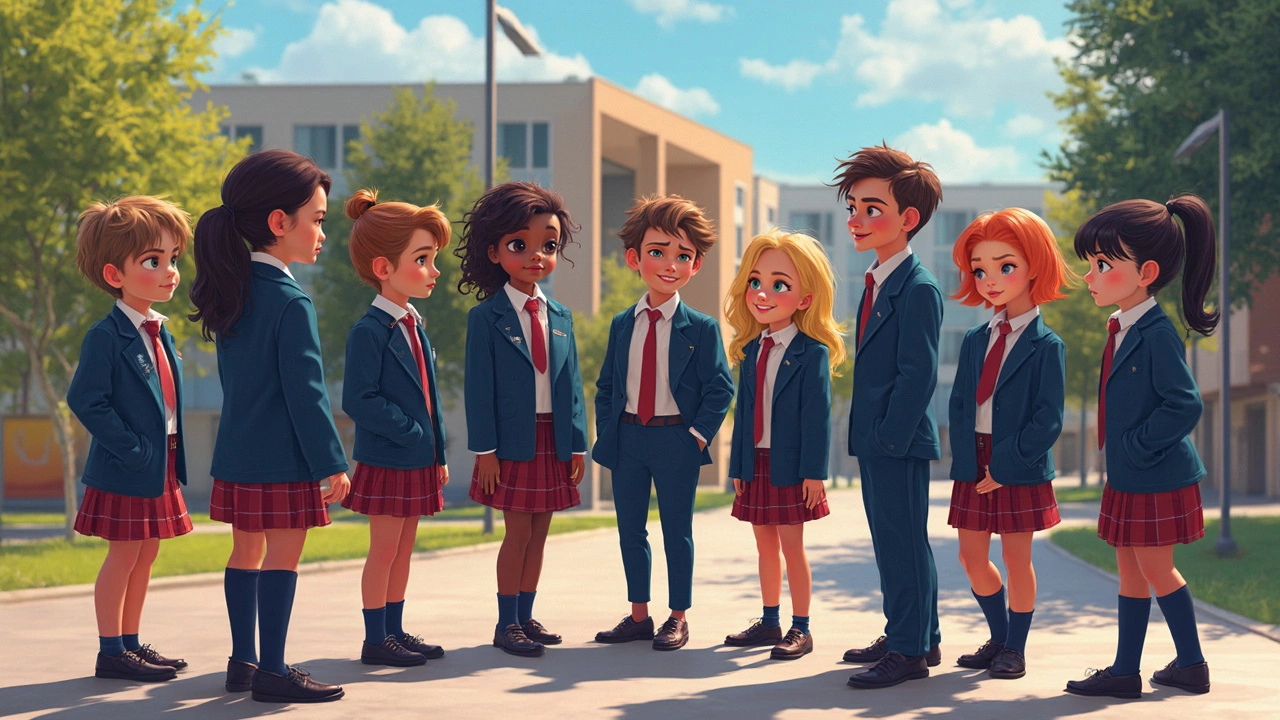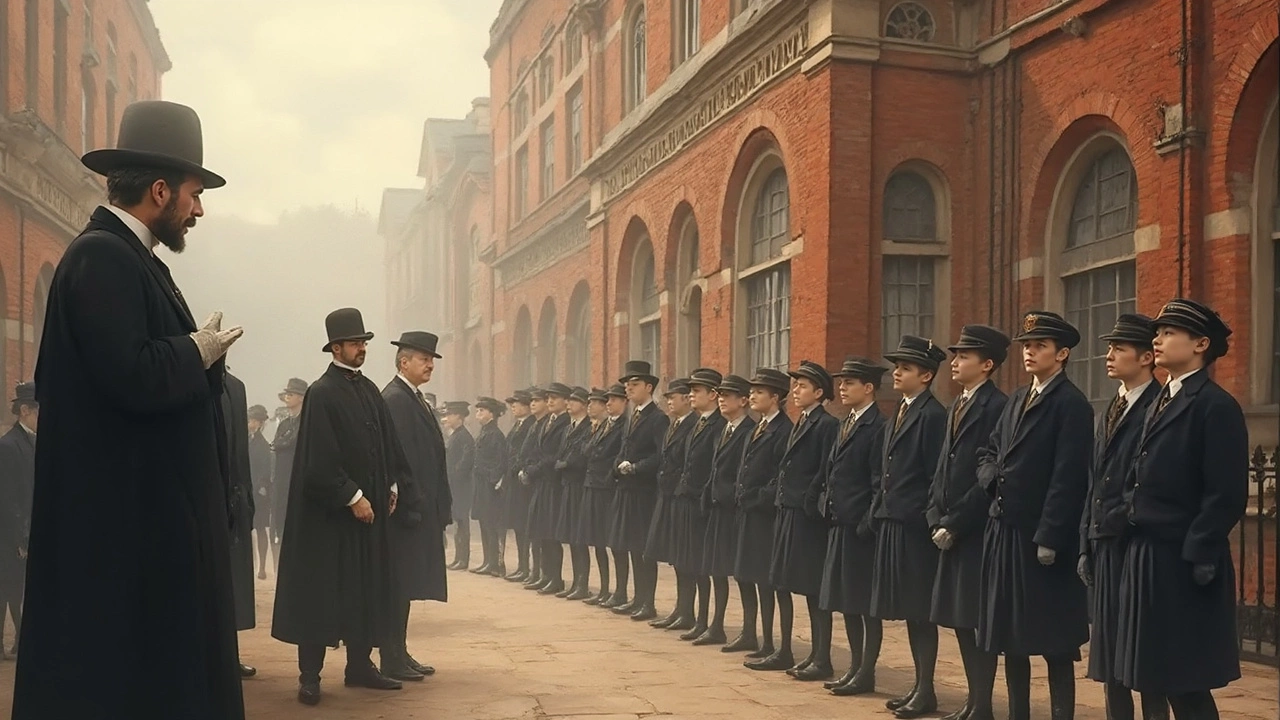Ever stopped to wonder why schools even made kids wear uniforms in the first place? Spoiler: It wasn’t just about looking neat for class photos. The story actually started almost 500 years ago, and it’s packed with some odd twists.
School uniforms first popped up in England, way back in the 1500s. The very first ones weren’t about style at all. They were for poor kids at charity schools, mostly to show who needed help. Uniforms became a sort of badge—if you wore a certain color or style, everyone knew exactly which school you belonged to. No mixing up students, and definitely no pretending to belong to a fancier school down the street.
Jump forward a couple hundred years, and uniforms weren’t just for the poor anymore. Fancy private schools adopted them too, turning uniforms into a sign of belonging and discipline. Suddenly, the thing that marked need also meant status. Kinda wild how the same jacket could mean different things depending on where you wore it.
- The First School Uniforms
- Uniforms Go Mainstream
- Reasons Schools Chose Uniforms
- How Uniforms Affect Students Today
The First School Uniforms
The whole idea of a school uniform started in England, way before anyone could imagine school as it is today. St. John’s Hospital in London was the first well-known place to get this going, giving out matching blue cloaks to poor students in the 1550s. People called these outfits “bluecoats”—not just because of the color, but because the whole group wore the exact same style, like a team. It wasn’t about style or class back then. It was more like a sign that these were charity kids. If you went to a ‘bluecoat’ school, everyone could spot you from a mile away.
Other schools picked up on the trend, mainly to make sure everyone looked the same and to cut down on distractions or bragging. By having a set uniform, students didn’t show off fancy clothes—something that could spark jealousy or feel awkward for families who couldn’t afford much.
Want some numbers? Check this out:
| School | Country | Year Introduced |
|---|---|---|
| Christ’s Hospital | England | 1552 |
| Charterhouse School | England | 1611 |
| St. Paul’s School | England | Early 1600s |
Everyone was in on the bluecoat trend back in the day. These weren’t comfy hoodies or stretchy pants—think knee-length coats, thick stockings, and sometimes hats that made students look almost the same as each other. For a lot of people, these strict outfits were the only clothes they had, so they just wore them outside of school too.
What’s wild is that the focus was way less about making everyone behave, and more about financial support and easy management. The school could keep track of kids, and pick out strangers right away. It wasn’t about pride or matching for fun—it was practical, almost like a uniform you’d see in a factory or shop.
Uniforms Go Mainstream
It’s kind of wild how school uniforms went from being a charity school thing to something everybody knew about. In the 19th century, uniforms started popping up everywhere in British schools. Even the prestigious Eton College made their famous tailcoat uniforms the standard for students. Around this time, uniforms weren’t just about rules – they became a whole culture on their own. Kids wearing blazers or caps weren’t just following dress codes; they were showing school pride.
Once the British Empire expanded, it took its school habits along for the ride. That’s why so many countries that were former British colonies—like India, Australia, and South Africa—ended up with uniforms in their schools too. By the early 20th century, school uniforms were everywhere. American public schools were a bit slow to jump on the trend, but by the 1980s, cities like Baltimore and Chicago began introducing uniforms as more parents got worried about bullying and gangs.
Here’s a quick look at how fast uniforms spread in just the last hundred years:
| Country | Year of Widespread Adoption | Current Uniform Usage (%) |
|---|---|---|
| United Kingdom | 1800s | 90% |
| Japan | Late 1800s | 95% |
| Australia | Early 1900s | 80% |
| South Africa | 1920s | 95% |
| United States | Late 1980s | 23% |
These numbers tell the story: in some countries, uniforms are basically a must, while in other places like the US, they’re less common but still growing in popularity. If your parents or grandparents grew up in Asia, they’ll probably have yearbook pictures in matching school blazers or sailor suits. In Africa and the Caribbean, uniforms are seen as a way to keep everyone equal, regardless of where they come from.

Reasons Schools Chose Uniforms
It wasn’t just a random rule—schools had concrete reasons for bringing in uniforms. One of the main ideas was about keeping things fair. When everyone wears the same clothes, no one stands out for being richer or poorer. That helps cut down on teasing or feeling left out because you can’t afford the “cool” brands.
Teachers and principals also wanted less distraction. No more arguments about what’s okay to wear or trying to show off. Just toss on your uniform and focus on what really matters—learning and getting through the day without dress code drama.
- School uniforms are used to boost a sense of community. Kids know they’re all on the same team, and that team feeling often leads to better school spirit and less bullying.
- Some schools claim uniforms actually improve behavior. According to a report from Oxford Brookes University, "Uniforms can positively influence students’ attitude and conduct, especially in schools with clear, simple uniform guidelines."
- Safety is also a factor. When everyone looks the same, strangers stick out. Staff can easily spot someone who doesn't belong, and that can help keep students more secure.
- Administrators like the simple side too. Uniforms mean fewer arguments about dress code violations and a lot less wasted time in the office over disputes about clothing.
There’s no single reason, but it all comes down to making school life a bit smoother and more equal for everyone involved.
How Uniforms Affect Students Today
When you think about school uniforms, the first thing that usually comes to mind is everyone looking the same every morning. But there’s more to it than matching shirts and pants. These days, uniforms do a lot in the daily life of students—sometimes good, sometimes not so much.
One huge reason schools stick with uniforms? They claim it cuts down on bullying. If everyone’s wearing the same thing, there’s less room to pick on others for not having the latest brands. A survey in 2023 found that 44% of U.S. schools with a uniform policy reported fewer student fights and bullying, compared to 27% of those without a dress code. That’s not nothing.
Parents often love uniforms because mornings get way easier—no more arguments over what to wear, just grab the outfit and go. It can also save money. Instead of buying a closet full of trendy clothes, you can get by with a few shirts and pants. Some families say they cut back school shopping costs by about 30% once their kids started wearing uniforms.
But there’s another side. Some kids—and honestly, a lot of teenagers—aren’t fans, saying uniforms squash their creativity and self-expression. There’s always that debate about letting students show their personalities at school. Plus, not every uniform is comfortable or made for all body types, which can be a real hassle.
Check out this quick breakdown of what students and parents say about school uniforms based on a 2024 survey:
| Positive Impact | Percent Noticing This Benefit |
|---|---|
| Reduced Bullying | 44% |
| Easier Morning Routines | 61% |
| Lower Clothing Costs | 39% |
| Challenge | Percent Noticing This Issue |
| Limits Self-Expression | 54% |
| Discomfort or Unfit Styles | 29% |
At the end of the day, school uniforms spark a lot of debate. Some students feel less pressure when they don’t have to keep up with fashion. Others just want to put their own spin on what they wear. If you’re weighing in on the dress code debate, these numbers can be good ammo—no matter what side you’re on.
- If your school allows it, try accessorizing in subtle ways to show a bit of your style—pin, shoes, or even your backpack.
- If uniforms are uncomfortable, speak up at school meetings. Some schools do tweak uniforms based on student feedback.
- Set up a second-hand uniform swap with other families to save even more money.
